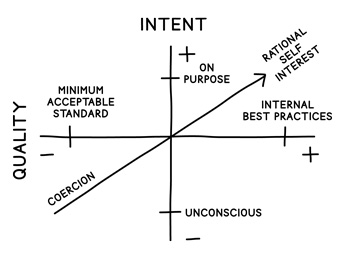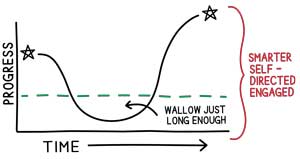Business Growth Consulting 306 This week: Communicatin’, Coercin’, Social media’n

GREG’S BUSINESS GROWTH NEWSLETTER #306
————————————————————
Quick notes to help you grow your business in less time with less effort. . . sometime next week.
In this issue:
– Techniques for FIT
– Being Human
– Random Stuff
Techniques for FIT
——-
- Use your words purposefully. There is a time to say, “I’m not sure, but. . .” and a time to go right into whatever you were going to say after “but. . .” Choose with purpose.
- Knowing there are options keeps us loose and open to possibilities. When our brain perceives no options it shuts down creativity. Train your people to think, “How would we. . .?” and “What would have to happen. . .?” questions.
- Your people remember more about how you say it than what you say. When I ask, “what did you hear?” it can be way off the mark, especially confirming emotional things, like intent.
- Your instructions are never as clear as you think. I learn this each fall when teaching a new group of high schoolers. What is clear to some, isn’t clear to all. The trick is to catch it before they do too much work based on a misunderstanding.
Being Human – Coercion vs self-motivation
————————————————————
“Company cultures are like country cultures. Never try to change one. Try, instead, to work with what you’ve got.” – Peter Drucker
I ran across this 2×2 grid from an old project.

The challenge in the company was (and still is) getting junior people to buy into the firm’s commitment to excellence. This excellence is demonstrated daily by senior leadership. The junior people, many of them Gen Z or young Millennials, are expected to learn through osmosis, watching daily interactions between leaders and clients.
To help them I set out to identify where exactly this disconnect showed up in their business. Was there a report somewhere? Were they looking at certain experiences? It took time, but we found measuring the number of client issues escalated to the senior level as one metric. Measuring passive-aggressive complaints in the annual customer survey is the second metric.
Quality vs Intent
The grid came from surveying the senior leaders and the junior staff. On the X axis we found there was an unwritten expectation in the job requirements, which we call the minimum acceptable standard. It’s the least you can do without getting fired. (which was not the same as the written job requirement, by the way) We put this on the low side. On the high side of the X axis were the firm’s best practices exhibited by the senior leaders. This is what we’re aiming for.
On the Y axis I put whether these were being done consciously or unconsciously. As you can imagine, some people scraping along at the minimum standards had no idea they were there. At the same time many of the leader’s best practices were not communicated.
We want all of our people to be in the top right. They know the best practices, and they do them on purpose. We can live with best practices done unconsciously too. Most of all, we want our people to do these things because they want to. It’s in their best interest, we say. A rational person wants to do the best they can. When you operate in the top right of the grid, you’re exhibiting those rational self-interest behaviors.
Bottom left may need some coercion. Top left is an issue. Surprisingly, there were a few senior leaders in this area. Incredibly competent, but not demonstrating the firm’s values, and acting that way on purpose. Most surprisingly to my team were the number of best practices not tracked or communicated. The outcomes the top people produced were consistent, but the way they got them was not.
We set out to raise awareness, to go from unconscious to on-purpose, and guess what? Yep, escalated complaints went down and survey complaints started looking different. (as often happens, old metrics give way to new ones as projects progress)
Takeaways
My reinforced takeaway is you have to check for awareness before taking action on bad behavior. I’m never surprised when people say, “oh, I didn’t know that.” My surprise takeaway is you have to check for awareness before taking action on good results. When you hear, “doesn’t everyone do it this way?” it’s a clue they need to talk to each other more structured way.
A firm’s culture is hard to change, but it starts with awareness. (And maybe give the young people a break because there are a lot of hidden rules to navigate. It’s not intuitive.)
Random stuff
————————————————————
“The greatest danger in times of turbulence is not the turbulence – it is to act with yesterday’s logic. – Peter Drucker

I took myself off social media for a month-ish. It’s hard because the best minds of a generation have been putting all their brainpower into making these tools “sticky.” To break free I needed to delete the apps, then force myself to log out on every web browser. Now, if I want to peek at one of these networks I have to log in which triggers me to think, “am I this bored?”
I found I don’t miss much. The news is a lot less interesting when the “hot take” is removed. The ways they try for my attention start to stick out a little more. Being in sales and marketing, I have been taking notes. “be more controversial” I write but can’t get myself to do it. Yet.
Anyway, my favorite team, the Denver Broncos, won a game and college basketball is starting. Those two events drove me back into the social media world. Here are some things I’ve missed:
- I am missing a lot of news context. A lot. So I’m filling in the blanks with my imagination. If we see one another over the holidays expect some misinformation.
- The information bubble thing is real. People talk to me about things I just don’t bump into in day-to-day life. The metaverse is already here.
- Among some classicists, “phallus Thursday” is still a thing. The seven-year-old in me still cracks up at every image.
I am human, so I’ll be pulled right back into social media, unable o resist knowing who the players are and what their beef is. As much as I enjoy the digital distraction, I did have fun with my little online vacation to the early 2000s. It confirms what the old man sings, the times they are a changin’.
————————————————————
If you need to set up a time to visit, follow this link:
https://calendly.com/chamberspivot/
